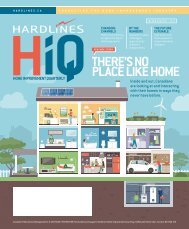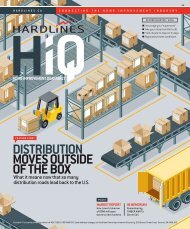HHIQ_1Q_18_complete
Create successful ePaper yourself
Turn your PDF publications into a flip-book with our unique Google optimized e-Paper software.
MERCHANDISING<br />
WHAT SHOULD WE SELL?<br />
Deciding what to sell may be the biggest factor in determining an independent dealers’ profitability and long-term<br />
success. As a dealer, you need to work extra hard to fill your customers’ needs when they walk through your door—<br />
otherwise there’s a good chance they won’t be back.<br />
S<br />
urveys regularly show that the<br />
number one reason customers<br />
make the trip to your store is<br />
because they believe you have what they<br />
need. Yet, today, customers can sit on their<br />
couches and find pretty much anything<br />
they need online.<br />
The right answer to what you should sell<br />
is different for every dealer and depends on<br />
many factors. Dealers in smaller communities<br />
often need to sell a broader range of<br />
product than those in larger communities.<br />
This seems counterintuitive, but in small<br />
communities, even 100 percent market<br />
share in limited categories won’t generate<br />
enough sales to keep the business viable.<br />
Some of these stores need to compete in<br />
more categories than much bigger stores in<br />
larger markets just to survive.<br />
I regularly see lumber yards in small<br />
communities get into the hardware business<br />
to generate more sales. This is hardly<br />
a new trend. Unfortunately, these dealers<br />
often decide to delegate decisions about<br />
what to sell in their front end to their vendors<br />
or distributors. They succumb to the<br />
lure of program buys, which look pretty and<br />
fill the space with no thought, analysis, or<br />
hard work required.<br />
I recently visited a newly merchandised<br />
store in a small town. They had a beautiful<br />
display of switch plate covers in every imaginable<br />
shape and colour. The display was<br />
eight-feet wide and seven-feet tall. The next<br />
aisle over featured a display of gate hardware<br />
in multiple sizes and colours. I’ve never seen<br />
displays of these products even remotely this<br />
broad at Lowe’s or Home Depot.<br />
Pre-set programs of products give vendors<br />
the opportunity to maximize their own sales.<br />
By putting in a full program rather than the<br />
typical 20 percent of products which then<br />
F LE<br />
By better satisfying customers already<br />
in your store, you will attract more of<br />
this type of customer and make your<br />
existing customers even more loyal.<br />
represent 80 percent of the store’s sales, the<br />
vendor’s selections mathematically generate<br />
25 percent more sales. In many categories,<br />
even that 25 percent is overstated since without<br />
those extra choices, the customer would<br />
have been quite satisfied to choose from the<br />
more popular colours and sizes.<br />
The problem then for dealers is the full<br />
program may take up twice the space or<br />
more. This kills the opportunity to display<br />
more categories or more product lines<br />
within the category.<br />
Take control of your store and make conscious<br />
choices of what you will sell and why.<br />
If your primary business is lumber and<br />
building materials, start with the hardware<br />
needed to install these products. By better<br />
satisfying customers already in your store,<br />
you will attract more of this type of customer<br />
and make your existing customers even<br />
more loyal. You will sell more LBM products<br />
on top of your incremental hardware sales.<br />
If space permits, add in the rough-in<br />
products such as plumbing and electrical<br />
and make sure you have enough depth and<br />
breadth of product that customers won’t be<br />
forced to go elsewhere for some of the basic<br />
BY ROB WILBRINK<br />
components. Here it’s important to find a<br />
vendor who understands local codes and<br />
can service these categories regularly to<br />
ensure products turn efficiently.<br />
The next priority is to devote some space<br />
to displays of the broad range of building<br />
materials available through your store.<br />
Once these basics are satisfied, the factors<br />
listed above come into play in deciding what<br />
else to sell.<br />
Once you’re happy with your assortment,<br />
use your POS system to generate item movement<br />
reports to identify items that haven’t<br />
sold in the past 365 days. Clear them out and<br />
purge them from your system. Then fill the<br />
hole with another product and if you have<br />
enough holes, consider adding another category<br />
that your customers will appreciate.<br />
Rob Wilbrink is the president and CEO<br />
of Burlington Merchandising and Fixtures<br />
(BMF). BMF provides a full range of services<br />
for independent dealers, including category<br />
strategy development, store layout and design,<br />
assortment planning, project management,<br />
design, supply, and installation of store fixturing<br />
and signage, carpentry, and merchandising.<br />
40 FIRST QUARTER / 20<strong>18</strong><br />
Hardlines Home Improvement Quarterly<br />
www.hardlines.ca
















